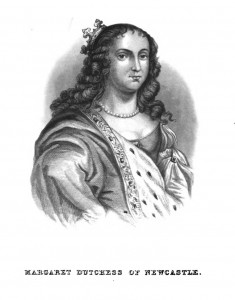
Margaret Cavendish [née Lucas], Duchess of Newcastle-upon-Tyne (1624?-1674) was born at St John’s Abbey in Essex. She was educated by private tutors, but not beyond a rudimentary level. Her tutors were probably elderly women without substantial connections to scholars who merely taught her reading and writing. Cavendish wrote the autobiographical ‘A true relation’ detailing an idyllic childhood, but claiming that her father was a wealthy gentleman who bore no other title. In the autumn of 1642, Margaret moved to Oxford, where Queen Henrietta Maria resided. The following year, Margaret became a maid of honor to the queen. In 1644, she joined the royal court and fled to Paris, where she met royalist commander William Cavendish, who had been disgraced by his defeat at Marston Moor. They wed the following year—an event that probably saved Margaret from obscurity. Her brother, Sir Charles Lucas, was executed as a royalist in 1648. In November, 1885, Margaret traveled to England with Sir Charles Cavendish, her brother-in-law, in an unsuccessful bid to secure as her husband’s sequestered estates. Her inability to reappropriate her husband’s former possessions resulted to a large extent from his vilification as ‘the greatest traitor to the state.’ After the Restoration, William Cavendish did not receive a court office. These events were to have a significant impact on Cavendish’s writings.
Margaret Cavendish published some twenty-three books, including plays, poetry, scientific and philosophical discourses. Among most notable and popular of her writings include The Blazing World (1666), an early form of science fiction with flamboyant depictions of otherworldly creatures and political satire. In Philosophical Letters, Cavendish offers critiques of works by Thomas Hobbes, Rene Descartes, Henry More, and J.B. van Helmont. Cavendish’s philosophy paralleled that of Hobbes in her assertion that all changes observed in nature must involve motion. She also insisted that no incorporeal substance can exist.
Given the prominence of women protagonists within books like The Blazing World, feminists often find common ground within her writings. According to Battigelli, Cavendish’s history of exile along with Queen Henrietta Maria instilled within her a militaristic view of the world. In 1667, The Life of William Cavendish was published to cast her husband’s military career in a positive light, and to showcase their life together while in exile in Antwerp.
Critical reviews of Margaret Cavendish’s writings have been historically mixed. Though little evidence has been collected to piece together a complete picture of how her contemporaries viewed her, Cavendish has elicited a wide range of opinions. In 1929, Woolf commented that “though her philosophies are futile, and her plays intolerable, and her verses mainly dull, the vast bulk of the Duchess is leavened by a vein of authentic fire.” The prevailing feminist interpretation has evolved from viewing her writing fallacies as the product of a male-dominated world, to viewing her as a gifted writer who is profligate in the use of parody and the avoidance of vague and contradictory works. Of all her works, The Blazing World generates the greatest amount of contemporary interest and scholarship.
Barry Cole
Additional Resources
Fitzmaurice, James. “Cavendish , Margaret, duchess of Newcastle upon Tyne (1623?–1673).”
James FitzmauriceOxford Dictionary of National Biography. Online ed. Ed. Lawrence
Goldman. Oxford: OUP, . 15 Sept. 2014 <http://www.oxforddnb.com/view/article/4940>.
Wikipedia contributors. “Margaret Cavendish, Duchess of Newcastle-upon-Tyne.” Wikipedia,
The Free Encyclopedia. Wikipedia, The Free Encyclopedia, 19 Aug. 2014. Web. 15 Sep. 2014.